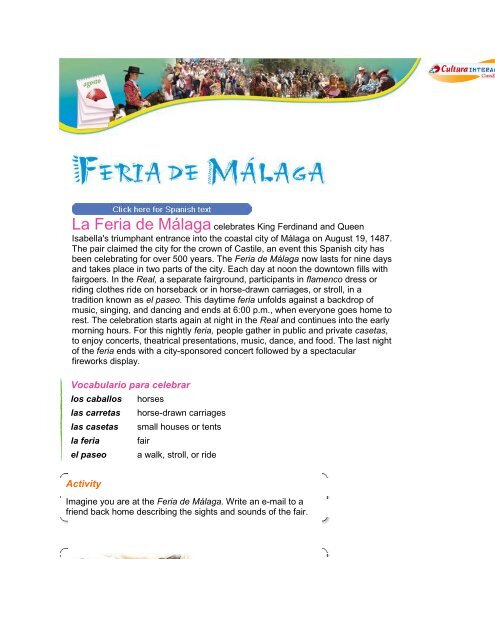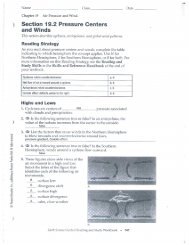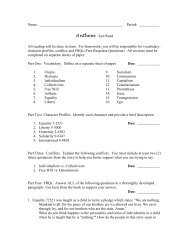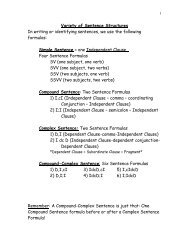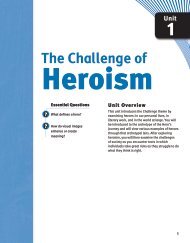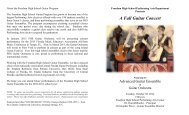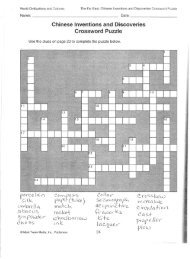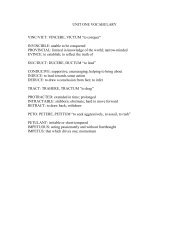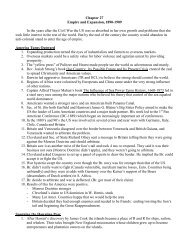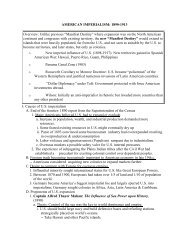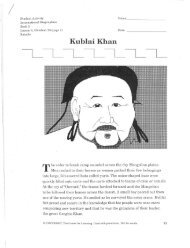Vocabulario para celebrar Activity - OCPS Teacher Server
Vocabulario para celebrar Activity - OCPS Teacher Server
Vocabulario para celebrar Activity - OCPS Teacher Server
Create successful ePaper yourself
Turn your PDF publications into a flip-book with our unique Google optimized e-Paper software.
La Feria de Málaga celebrates King Ferdinand and Queen<br />
Isabella's triumphant entrance into the coastal city of Málaga on August 19, 1487.<br />
The pair claimed the city for the crown of Castile, an event this Spanish city has<br />
been celebrating for over 500 years. The Feria de Málaga now lasts for nine days<br />
and takes place in two parts of the city. Each day at noon the downtown fills with<br />
fairgoers. In the Real, a se<strong>para</strong>te fairground, participants in flamenco dress or<br />
riding clothes ride on horseback or in horse-drawn carriages, or stroll, in a<br />
tradition known as el paseo. This daytime feria unfolds against a backdrop of<br />
music, singing, and dancing and ends at 6:00 p.m., when everyone goes home to<br />
rest. The celebration starts again at night in the Real and continues into the early<br />
morning hours. For this nightly feria, people gather in public and private casetas,<br />
to enjoy concerts, theatrical presentations, music, dance, and food. The last night<br />
of the feria ends with a city-sponsored concert followed by a spectacular<br />
fireworks display.<br />
<strong>Vocabulario</strong> <strong>para</strong> <strong>celebrar</strong><br />
los caballos horses<br />
las carretas horse-drawn carriages<br />
las casetas small houses or tents<br />
la feria fair<br />
el paseo a walk, stroll, or ride<br />
<strong>Activity</strong><br />
Imagine you are at the Feria de Málaga. Write an e-mail to a<br />
friend back home describing the sights and sounds of the fair.
Música callejera Musicians<br />
play in the streets during the<br />
feria. Here a panda, or group,<br />
plays verdiales, traditional<br />
music that features guitars,<br />
tambourines, and tiny cymbals.<br />
Feria de caballos More than a<br />
thousand riders and over a<br />
hundred horse-drawn carriages<br />
and carts participate in el<br />
paseo.<br />
Bailando flamenco Fairgoers<br />
perform folkloric dances such<br />
as flamenco and sevillanas in<br />
the streets, plazas, and<br />
casetas, wherever there is<br />
music.<br />
Una caseta offers free samples<br />
of paella, a rice and seafood<br />
dish that is a regional specialty<br />
from the coastal cities of Spain.
Una entrada a la feria Riders<br />
pass in front of one of the<br />
decorative entrances to a street<br />
in the historic downtown of<br />
Málaga.<br />
1. Does your town or city celebrate its beginnings or inauguration as a community, or is there a<br />
special “town day”? What events take place during the celebration?<br />
2. What events in your community or region are similar to those of the Feria de Málaga? Describe<br />
them and then compare them to the Feria de Málaga.
El Día de la Independencia falls in September for many of<br />
the Spanish-speaking countries in the Americas. Mexico celebrates on<br />
September 15 and 16, with the Grito de la Independencia, music, fireworks, and<br />
<strong>para</strong>des. The first Grito occurred at dawn on September 16, 1810, when Padre<br />
Miguel Hidalgo de Costilla called to the people of Dolores to rise up against the<br />
Spanish crown. That rebellion led to the Mexican War of Independence.<br />
Just two days later, on September 18, 1810, Chile declared its independence<br />
from Spain. Today Chile celebrates the date during a week of fiestas patrias that<br />
include <strong>para</strong>des, rodeos, dance competitions, and special foods.<br />
Eleven years later, on September 15, 1821, a large part of Central America also<br />
proclaimed its independence from Spain, becoming El Salvador, Nicaragua,<br />
Guatemala, Costa Rica, and Honduras. These countries celebrate their<br />
independence on the 14 and 15 with a focus on students: <strong>para</strong>des, assemblies,<br />
and sports competitions.<br />
<strong>Vocabulario</strong> <strong>para</strong> <strong>celebrar</strong><br />
la antorcha torch<br />
la banda band<br />
las fiestas patrias patriotic holidays<br />
el grito shout<br />
el recorrido run, journey<br />
proclamar to declare<br />
<strong>Activity</strong><br />
Describe three activities that take place during the Mexican and<br />
Central American Independence Day celebrations in which you<br />
would like to participate.
El Grito de la Independencia<br />
On the night of September 15,<br />
the president of Mexico<br />
commemorates el Grito by<br />
ringing a bell, proclaiming ¡Que<br />
viva México!, and waving the<br />
Mexican flag from a balcony<br />
above the Zócalo. Crowds<br />
gather below to participate in<br />
the Grito.<br />
Fiestas patrias Costa Rican<br />
school children, dressed in<br />
colors of their country, dance in<br />
a <strong>para</strong>de.<br />
El recorrido de la antorcha<br />
Runners carrying a flaming<br />
torch start in Guatemala and<br />
end in Costa Rica. All along the<br />
route, uniformed schoolchildren<br />
wait expectantly for the torch to<br />
pass.
1. Compare the way your town or city celebrates Independence Day with the celebrations in Mexico<br />
and Central America. How are they similar? Are there any differences?<br />
2. How do you celebrate Independence Day? Do you participate in community events or have a<br />
special tradition?
El 12 de Octubre has many different meanings in the Spanishspeaking<br />
world. For some people it is el Día de Colón, the day Christopher<br />
Columbus arrived in the Americas. For some, it is el Día de la Hispanidad, a day<br />
to celebrate one’s connection with all other Spanish-speaking people, regardless<br />
of their country. And for others, it is el Día de la Raza, a day when indigenous<br />
people come together as a community and celebrate their heritage. Other<br />
Spanish speakers celebrate their mixed heritage of indigenous, African, and<br />
European cultures. How you celebrate depends very much on you and your<br />
family’s origin and on the community where you live. For all Spanish-speaking<br />
groups, el 12 de octubre marks a key turning point in the lives and cultures of the<br />
people in Spain and those living in the Americas.<br />
<strong>Vocabulario</strong> <strong>para</strong> <strong>celebrar</strong><br />
Cristóbal Colón Christopher Columbus<br />
el Día Nacional National Day<br />
la hispanidad the cultural community of Spanish speakers<br />
la raza race<br />
<strong>Activity</strong><br />
In what country or city would you like to witness the events of<br />
October 12? Explain why.<br />
Día de la Raza Indigenous<br />
groups gather in Mexico City<br />
dressed in their community’s<br />
traditional outfits, some wearing<br />
pre-Columbian clothing and<br />
headdresses.
Día Nacional de España The<br />
Spanish government celebrates<br />
with a <strong>para</strong>de in Madrid.
Día de la Raza A woman from<br />
the Pehuenche indigenous<br />
community gathers with other<br />
indigenous groups in downtown<br />
Santiago.<br />
Día de la Hispanidad High<br />
school students carry flags<br />
representing all the American<br />
countries as they march in a<br />
<strong>para</strong>de down Fifth Avenue.<br />
1. How do you celebrate October 12 in your community or school? Is it similar to or different from<br />
the celebrations in Spanish-speaking countries? How so?<br />
2. What does October 12 mean to you? Which of the Spanish names for the holiday has the most<br />
meaning for you? How would you rename the holiday to celebrate your heritage?
On Día de los Muertos families visit the cemeteries and<br />
gravesites of their loved ones. They clean the sites and leave flowers and<br />
candles and, in many countries, they bring entire meals with special drinks and<br />
traditional breads to share with the deceased. Displays are set up next to the<br />
gravesite that include flowers, hand-crafted skeletons, colorful paper cutouts,<br />
candy skulls, personal items, and photos. Family members pass the night<br />
sharing food and conversation as they keep vigil for their ancestors.<br />
The celebration of Día de los Muertos spans two days, November 1 and 2. Also<br />
known as Día de los Difuntos, the traditions originate in the centuries-old<br />
religious holiday Día de Todos los Santos. In the Americas, this holiday coincided<br />
with pre-Columbian festivals that celebrated the harvest, the new year, and<br />
honored the dead. The mix of cultures and traditions resulted in the celebration<br />
Día de los Muertos.<br />
<strong>Vocabulario</strong> <strong>para</strong> <strong>celebrar</strong><br />
las calaveras skulls<br />
el cementerio cemetery<br />
los difuntos deceased<br />
el esqueleto skeleton<br />
el pan de muertos special bread made for Día de los Muertos<br />
el papel picado paper cutouts<br />
los santos saints<br />
<strong>Activity</strong><br />
Explain the different ways Latin Americans make Day of the<br />
Dead a joyous celebration.
Las calaveras A display of<br />
dressed-up skulls and<br />
skeletons on a street in Mexico<br />
City.<br />
Las mojigangas People<br />
<strong>para</strong>de through the Pilsen-Little<br />
Village neighborhood of<br />
Chicago. Some carry<br />
mojigangas, giant papiermâché<br />
puppets typically carried<br />
in Mexican processions.<br />
El papel picado These tissue<br />
paper cutouts are a common<br />
holiday decoration. To<br />
celebrate Día de los Muertos,<br />
the cutouts form images of<br />
skeletons.
Los barriletes Guatemalans<br />
celebrate by flying barriletes, or<br />
colorful kites, to which they<br />
attach messages for the<br />
deceased. The town of<br />
Santiago Sacatepéquez<br />
celebrates with a barrilete<br />
contest.<br />
El pan de muertos This bread<br />
is made only for Día de los<br />
Muertos. In Ecuador, these<br />
breads are called guaguas de<br />
pan. Guagua is the Quechua<br />
word for “baby” and refers to<br />
the bread’s shape. The<br />
guaguas are served with<br />
colada morada, a warm,<br />
purple-colored drink made from<br />
blueberries and raspberries.<br />
1. Does your family or community have a special day or specific traditions to remember the<br />
deceased? How are they similar to or different from the traditions of Día de los Muertos?<br />
2. Centuries ago in Europe, the night of October 31, before All Saint’s Day, was known as “All<br />
Hallowed’s Eve.” According to ancient beliefs, on this night the dead join the world of the living.<br />
Today we call this night Halloween. How would you compare the celebrations of Halloween and<br />
Día de los Muertos?
Las Navidades are celebrated throughout the Spanish-speaking<br />
world with family gatherings and special meals. Celebrations start in mid-<br />
December and, in some countries, extend to January 6.<br />
Many families gather the night of December 24, or la Nochebuena, to share a<br />
special meal of traditional foods and drinks that vary depending on the country.<br />
Tamales, empanadas, and buñuelos are served in many countries. In Spain,<br />
there is turkey, or pavo, and turrón. In Argentina and Chile, where it is summer,<br />
people eat cold foods and salads.<br />
The tradition of giving and receiving gifts also forms a part of las Navidades. In<br />
some countries, families exchange gifts at midnight on la Nochebuena, while in<br />
others children receive gifts the morning of December 25, and in other countries<br />
the gifts appear the morning of January 6. Often gifts are given primarily to<br />
children.<br />
<strong>Vocabulario</strong> <strong>para</strong> <strong>celebrar</strong><br />
la Nochebuena Christmas Eve<br />
los Reyes Magos Three Kings<br />
la rosca de reyes sweet bread eaten on January 6<br />
el turrón almond nougat candy<br />
los villancicos seasonal children’s songs<br />
<strong>Activity</strong><br />
Which images of Christmas in the Spanish-speaking world are<br />
also seen in the United States? Which ones are unique to the<br />
region?<br />
Un desfile navideño The<br />
holiday <strong>para</strong>de in Panama
City takes place in mid-<br />
December.<br />
La noche de rábanos On<br />
the night of December 23,<br />
elaborate carvings made from<br />
radishes, or rábanos, are on<br />
display in Oaxaca’s central<br />
plaza. The figures include<br />
people, animals, and even<br />
entire scenes. This unique<br />
tradition has been celebrated<br />
for over 100 years.<br />
Las empanadas Dancers<br />
dress as empanadas in<br />
Buenos Aires. These meatfilled<br />
pies are especially<br />
enjoyed during las<br />
Navidades.<br />
El Día de los Reyes Magos<br />
In Peru, Argentina, the<br />
Dominican Republic,<br />
Paraguay, and Spain,<br />
children receive presents on<br />
January 6 from los Reyes<br />
Magos. In anticipation,<br />
children leave out a snack for<br />
the Three Kings, carrots or<br />
grass for the camels, and a<br />
pair of empty shoes for the<br />
gifts.
Un desfile navideño Circus<br />
elephants take part in<br />
Madrid’s holiday <strong>para</strong>de on<br />
January 5. In Spain, <strong>para</strong>des<br />
on January 5 or 6 celebrate<br />
the arrival of los Reyes<br />
Magos.<br />
1. Do you and your family celebrate a holiday in December? If so, compare the traditions of your<br />
family to the traditions of las Navidades.<br />
2. What special meals and foods do you associate with certain holidays? Describe the foods you<br />
traditionally enjoy on a holiday you celebrate.<br />
3. What time of the year do you give or receive gifts and for what reason?
El Año Nuevo celebrates the arrival of the New Year and la<br />
Nochevieja says goodbye to the old. In much of the Spanish-speaking world,<br />
traditions include making a toast, exchanging a kiss or hug, or eating twelve<br />
grapes—one for each stroke of midnight—to ensure your wishes come true for<br />
the New Year. Other good luck traditions include wearing yellow or red, eating a<br />
tablespoon of lentils, or carrying a suitcase around the block if you hope to take a<br />
trip. To wish someone a happy New Year, say ¡Feliz año nuevo! or ¡Próspero<br />
año nuevo!<br />
On Nochevieja, there are also traditions for saying goodbye to the old year.<br />
Some people dress in masks representing el año viejo. Others build satirical<br />
figures called los años viejos that represent famous people or politicians.<br />
Adorned with poems or messages that poke fun at el año viejo, and filled with<br />
shavings and firecrackers, these figures are lit on fire at midnight, to burn and<br />
explode on street corners, as a final despedida, or farewell, to the old year.<br />
<strong>Vocabulario</strong> <strong>para</strong> <strong>celebrar</strong><br />
el Año Nuevo New Year<br />
el brindis toast<br />
las doce uvas twelve grapes<br />
las lentejas lentils<br />
la medianoche midnight<br />
la Nochevieja New Year’s Eve<br />
<strong>Activity</strong><br />
What traditions of the Spanish-speaking world do you think are<br />
fun to welcome the New Year?
La buena suerte In Lima,<br />
people believe touching a<br />
Chinese Lion brings happiness,<br />
good luck, and prosperity in the<br />
New Year. Ten percent of<br />
Peru’s population is of Chinese<br />
descent.<br />
La medianoche In Madrid,<br />
people gather in the Puerta del<br />
Sol, holding bags of 12 grapes<br />
as they wait for the 12 strokes<br />
of midnight from the Puerta del<br />
Sol clock, the city’s official<br />
timekeeper.<br />
Baile de los Gigantes In<br />
Antigua, people celebrate the<br />
New Year with the folkloric<br />
“Dance of the Giants.” These<br />
giant heads, or cabezudos, are<br />
similar to costumes used since<br />
the medieval period in Spain.
Paseo de los años viejos In<br />
Popayán, families and<br />
neighbors take their año viejo<br />
figures out for a final ride<br />
before the Nochevieja<br />
celebration. Later on, at<br />
midnight, they will burn the<br />
figures.<br />
1. How do you celebrate the New Year? Does your family or community have any special traditions?<br />
Are any of the traditions similar to the ones in Spanish-speaking countries? How are they similar<br />
or different?<br />
2. If you were to build an año viejo representing the past year, what figure or event would you<br />
portray? Explain your choice.
Carnaval marks a period of festivity prior to the beginning of Lent. Lent<br />
was, and for some still is, a 40-day period of solemnity and fasting with the<br />
removal of meat from the diet being a key feature. You can see the word carne<br />
(meat) in Carnaval; traditionally, this was the last chance to eat meat before the<br />
Lenten fast. Today, Carnaval often resembles a lively, multi-day party.<br />
Falling in either February or March, Carnaval is typically celebrated during the<br />
five days that precede Ash Wednesday, the first day of Lent. In some countries,<br />
Carnaval lasts longer, overlapping other local celebrations. In many regions,<br />
traditions such as throwing water and eggs can start over a month before the<br />
actual holiday. The planning for the next year’s <strong>para</strong>des, parties, and dance<br />
groups often starts as soon as the current Carnaval ends!<br />
<strong>Vocabulario</strong> <strong>para</strong> <strong>celebrar</strong><br />
los bailarines dancers<br />
la banda musical band<br />
Carnaval Carnival<br />
los cascarones confetti-filled eggs<br />
el disfraz costume<br />
las máscaras masks<br />
<strong>Activity</strong><br />
Describe a costume you would design for Carnaval. What<br />
images inspired you?
Disfraces Elaborate costumes<br />
are central to the Carnaval<br />
celebration. This costume,<br />
entitled “África soy yo,”<br />
appeared in Las Palmas, in the<br />
Canary Islands.<br />
Carnaval Revelers dance in<br />
Encarnación, site of the largest<br />
celebration in Paraguay.<br />
Cascarones Breaking<br />
cascarones on the heads of<br />
friends and other party-goers is<br />
a Carnaval tradition. The<br />
sprinkling of confetti from these<br />
hollowed-out eggs is said to<br />
bring good luck, as seen here<br />
in Mazatlán.<br />
http://www.embassy-avenue.jp/<strong>para</strong>gu<br />
http://www.ahorre.com/<strong>para</strong>guay/<strong>para</strong><br />
_tourism.htm<br />
http://en.wikipedia.org/wiki/Encarnació<br />
%2C_Paraguay
Máscaras are a Carnaval<br />
tradition dating back to<br />
medieval Spain. This masked<br />
dancer is from the <strong>para</strong>de in<br />
Oruro, where some 40,000<br />
folkloric dancers and musicians<br />
participate.<br />
Bailarines folklóricos<br />
Dancers from the Mestizaje<br />
dance group perform in<br />
Barranquilla. The Colombian<br />
government proclaimed this<br />
city’s Carnaval celebration,<br />
which combines indigenous,<br />
African, and European<br />
traditions, a National Cultural<br />
Heritage. UNESCO declared it<br />
a “Masterpiece” for its cultural<br />
uniqueness.<br />
1. The ways in which Carnaval is celebrated in the Spanish-speaking world differ depending on the<br />
region. Why do you think the celebrations have evolved differently?<br />
2. Compare the traditions of Carnaval to any holiday that you celebrate. Which one(s) are similar?<br />
How are they similar?
Las Fallas is a weeklong festival in March that engulfs the city of<br />
Valencia, Spain. Tens of thousands of visitors from all over the world come to the<br />
city to experience Las Fallas, a week of pageants, music, flowers, and creative<br />
displays. Each day, the deafening explosions of thousands of firecrackers, la<br />
mascletà, fills the city at 2:00 p.m. and each night’s celebration ends in fireworks.<br />
The main characters of the celebration are the ninots, gigantic figures built of<br />
wood, plaster, and cardboard. The largest are up to several stories tall.<br />
Neighborhood organizations build these enormous figures during the preceding<br />
year. Then, during the week of Las Fallas, they display them in intersections,<br />
parks, and plazas throughout the city. The public visits the more than 400 fallas<br />
and votes for their favorite one. On the last night at midnight, all but the favorite<br />
are burned in enormous bonfires. Then one final, brilliant display of fireworks<br />
explodes over the city.<br />
<strong>Vocabulario</strong> <strong>para</strong> <strong>celebrar</strong><br />
La Cremà burning of the fallas<br />
las fallas displays of figures<br />
los falleros celebrants of Las Fallas<br />
los fuegos artificiales fireworks<br />
la mascletà rhythmic explosion of large and small firecrackers<br />
los ninots large papier-mâché figures<br />
quemar to burn<br />
<strong>Activity</strong><br />
Given the opportunity, what role would you like to have in Las<br />
Fallas? Explain why.
Los ninots These gigantic<br />
figures poke fun at well-known<br />
people or current events from<br />
the preceding year.<br />
Las falleras During the festival,<br />
women dress in traditional<br />
outfits that include lace<br />
dresses, veils, jewelry, and<br />
colorful sashes.<br />
Una falla iluminada<br />
Thousands of visitors come at<br />
night to see the illuminated<br />
fallas. This display was entered<br />
into a special contest, la<br />
Sección Especial, where a<br />
committee judges the fallas for<br />
creativity, gracefulness and<br />
charm, originality, and lighting.
La Cremà At midnight on the<br />
last night, the fallas are burned<br />
throughout the city. At the<br />
same time there are huge<br />
displays of colorful fireworks,<br />
which include explosions of<br />
roman candles and thousands<br />
of firecrackers.<br />
1. Fireworks are a major part of Las Fallas. Does your community or region have fireworks displays?<br />
When and for what reasons?<br />
2. Are there any other traditions in the festival of Las Fallas that are similar to traditions you follow<br />
in your community? What are they? Are they part of a specific celebration or season?
La Semana Santa is one holiday during the year where in most<br />
Spanish-speaking countries entire towns, businesses, schools, and government<br />
close for at least four days, Thursday through Sunday. People that have<br />
relocated to other places often go back to their hometowns. Others take<br />
advantage of the long break to go to the countryside or beach. Entire<br />
communities come together for Semana Santa celebrations. In some places,<br />
religious processions fill the streets each day of the week from Palm Sunday to<br />
Easter; in others, Thursday and Friday are the most important days. Most<br />
Semana Santa traditions are hundreds of years old and originated in Spain, but<br />
many now have a unique twist due to the mix of cultures in each country.<br />
<strong>Vocabulario</strong> <strong>para</strong> <strong>celebrar</strong><br />
las alfombras rugs<br />
las flores flowers<br />
las procesiones processions<br />
Semana Santa Holy Week<br />
<strong>Activity</strong><br />
Write a travel brochure, describing five things tourists can see<br />
during Easter Week.<br />
Alfombras de aserrín Rugs<br />
traditionally made of colored<br />
sawdust or sand, flowers, and<br />
fruits cover the streets where<br />
processions will pass in<br />
Sonsonate. Artisans also now<br />
use modern industrial paints<br />
and sprays.
Vestidos blancos Girls from<br />
San Miguel de Allende dress in<br />
white for the procession on<br />
Viernes Santo. In this town, the<br />
celebrations extend for two<br />
weeks, ending on el Domingo<br />
de Pascua with an explosion of<br />
papier-mâché figures in the<br />
center of town.
La fanesca Ecuadorians eat<br />
fanesca, a bean and grain soup<br />
with a fish base, only during<br />
Semana Santa. The soup is<br />
traditionally served with bolitas<br />
de harina (fritters), plátano<br />
verde (fried green plantain),<br />
fresh cheese, and ají, a spicy<br />
sauce.<br />
Decoraciones de flores<br />
Flowers fill the city of Tarma for<br />
the Semana Santa<br />
celebrations. In pre<strong>para</strong>tion for<br />
the processions that begin on<br />
Thursday, arches and rugs<br />
made of flowers decorate the<br />
streets and remain on display<br />
until Sunday.
Una procesión Young boys<br />
carry streamers during the<br />
processions in Cadereyta.<br />
1. What holidays do you celebrate with special <strong>para</strong>des or processions? What kinds of<br />
decorations do people use?<br />
2. In what kind of event would most of the people in your community participate? Compare the event<br />
to Semana Santa.
Cinco de Mayo has become a popular celebration throughout the<br />
United States. However, not everyone who celebrates this uniquely Mexican<br />
holiday knows its origin. To find the reason, you must travel back to the year<br />
1862 in Mexico. On May 5, in the town of Puebla de los Ángeles, the Mexican<br />
army, joined by farmers and townspeople, fought against the French and<br />
forced them to retreat. The Mexicans were led by General Ignacio Zaragoza<br />
and the town was later renamed Puebla de Zaragoza in his honor. Although<br />
the French went on to occupy Mexico City and assume a short-lived role in<br />
Mexico’s government, Cinco de Mayo became a national holiday symbolizing<br />
Mexican unity.<br />
A Cinco de Mayo celebration in Mexico includes dancing, music, and<br />
reenactments of the battle. In many parts of the U.S. where there is a large<br />
Mexican or Mexican-American community, you will often find Cinco de Mayo<br />
celebrations.<br />
<strong>Vocabulario</strong> <strong>para</strong> <strong>celebrar</strong><br />
los bailarines dancers<br />
la batalla battle<br />
el ejército army<br />
los franceses French<br />
los músicos musicians<br />
la reconstrucción reenactment<br />
<strong>Activity</strong><br />
Explain some differences between the celebration of Cinco de<br />
Mayo in México and the celebration in the United States.
Mariachis y bailarines<br />
Folkloric dancers and<br />
musicians perform throughout<br />
the day in the Plaza Olvera<br />
during the Cinco de Mayo<br />
celebrations.<br />
Reconstrucción de la batalla<br />
A reenactment of the historic<br />
battle in Puebla commemorates<br />
Mexico’s victory over the<br />
French.<br />
Bailarín folklórico A dancer<br />
performs in a traditional<br />
Mexican costume at the White<br />
House.
1. Do you know of a Cinco de Mayo celebration in your community or region? If so, how or where is<br />
it celebrated?<br />
2. What important battles or historic events are celebrated in your community or state? How are they<br />
celebrated? Are they local or national holidays? Compare one of these holiday celebrations with<br />
the Cinco de Mayo celebrations.
Inti Raymi, or the “Festival of the Sun,” falls on June 21 or 22, the date<br />
of the southern hemisphere’s winter solstice, the shortest day of the year.<br />
Indigenous communities throughout the Andean highland countries of South<br />
America celebrate the winter solstice with ceremonies designed to bring the Sun<br />
back and shorten the longest night. Incan in origin, Inti Raymi honored the sun as<br />
the source of light, heat, and life, and celebrated the start of a new planting<br />
season. The name Inti Raymi comes from the Quechua language: inti means<br />
“sun” and raymi means “festival.” The largest festival takes place in Cuzco, Peru,<br />
the ancient capital of the Incan civilization and empire. In Cuzco, Inti Raymi has<br />
grown into a major tourist attraction. Thousands of people visit the city to enjoy<br />
the performances by folkloric groups and to watch the theatrical presentation of<br />
the Incan ceremony, the focal point of the celebration.<br />
<strong>Vocabulario</strong> <strong>para</strong> <strong>celebrar</strong><br />
el aymara language of indigenous group from Bolivia and Peru<br />
los incas Incas, an ancient South American people<br />
el quechua language common to many South American indegenous<br />
el sol sun<br />
<strong>Activity</strong><br />
groups and adopted and spread by Incas<br />
Choose three adjectives that describe Inti Raymi. Explain each<br />
choice.
Presentación cultural de Inti<br />
Raymi In Cuzco, professional<br />
actors and actresses interpret<br />
the roles of the Incan emperor<br />
and others. Above: A woman<br />
carries offerings. Below: The<br />
Incan emperor passes through<br />
the streets of Cuzco to the<br />
ruins of the Incan fortress,<br />
Sacsayhuaman.<br />
Indígenas ecuatorianas A<br />
dance group from the<br />
Paktarinmi cultural organization<br />
forms a “sacred circle” with<br />
grains of corn, a pre-Incan rite.<br />
In Ecuador, which lies on the<br />
equator, this date is considered<br />
the summer solstice, rather<br />
than the winter.
Los aymaras In the pre-<br />
Columbian ruins of Tihuanaku,<br />
an Aymara priest blows on a<br />
shell to celebrate the winter<br />
solstice, which marks the new<br />
year. The Aymara are one of<br />
two dominant indigenous<br />
groups in Bolivia, comprising<br />
25 percent of the population.<br />
The other group, Quechua,<br />
makes up 30 percent.<br />
1. In North America, June 21 is the summer solstice, or the longest day of the year, and<br />
December 21 is the winter solstice, or the shortest day of the year. What important<br />
holidays or events occur during this time of year?<br />
2. In ancient civilizations, the appearance of the sun and moon were important events<br />
that helped mark the passing of time and the seasons. If you were to celebrate the<br />
winter or summer solstice, what would you include in your celebration?
Simón Bolívar, known as El Libertador, envisioned a united South<br />
America, a union for which he fought, but never attained. Despite this, he was<br />
instrumental in bringing about much of South America’s independence from<br />
Spain and became one of its most revered leaders. His birthday is a national<br />
holiday in Venezuela, Ecuador, and Bolivia, and many cities and towns have<br />
plazas or monuments in his honor.<br />
Born on July 24, 1783, in Caracas, Venezuela, Simón Bolívar strongly believed in<br />
freedom from Spanish rule and worked toward that goal as a political leader,<br />
writer, and military commander. With his troops, he liberated present-day<br />
Venezuela, then Colombia. He was then named president of Gran Colombia, a<br />
federation comprised of what is now Venezuela, Colombia, Panama, and<br />
Ecuador. He went on to lead his troops into Peru, aiding in the final defeat of<br />
Spain. For two more years, Bolívar maintained his leadership, writing the<br />
constitution of Bolivia, a country named in his honor. By 1827, his dream of<br />
unification dissolved amidst growing rivalries between the South American<br />
military leaders. Three years later Bolívar died, on December 17, 1830.<br />
<strong>Vocabulario</strong> <strong>para</strong> <strong>celebrar</strong><br />
la batalla battle<br />
la independencia independence<br />
El Libertador the liberator<br />
<strong>Activity</strong><br />
How is Simón Bolívar the George Washington of Colombia,<br />
Venezuela, and Ecuador? Think about battles, presidencies,<br />
money bills, and names of states.<br />
http://www.simon-bolivar.org/
Simón Bolívar (1830), José<br />
Gil de Castro José Gil de<br />
Castro, renowned painter of<br />
Chilean society and of the<br />
independence leaders, painted<br />
this portrait of Bolívar in the<br />
early 1800s.<br />
Monumento a Simón Bolívar<br />
This monument marks the<br />
location of the Battle of Boyacá,<br />
where Bolívar’s forces defeated<br />
the Spanish resulting in the<br />
liberation of Gran Colombia. To<br />
celebrate the anniversary of the<br />
battle, students form the colors<br />
of the Colombian flag.<br />
http://www.embavenezus.org/kids.ve<br />
simon.bolivar.htm?pagina=kids.vene<br />
economy.htm<br />
http://www.artnet.com/library/01/0148<br />
T014827.asp<br />
http://www.puc.cl/faba/ARTE/MUSEO<br />
ExpoGilI.html
Bolívares Venezuela’s<br />
currency carries both Bolívar’s<br />
name and image.<br />
Líder de la Batalla de<br />
Pichincha Each year, the city<br />
of Quito commemorates the<br />
Battle of Pichincha, where<br />
Simón Bolívar sent troops<br />
under the command of Antonio<br />
José de Sucre to defeat the<br />
Spanish in one of the crucial<br />
battles in the fight for<br />
independence.<br />
Plaza de Bolívar This statue of<br />
Bolívar is located in the Plaza<br />
Bolívar, the historic, political,<br />
and commercial center of<br />
Caracas.<br />
1. What famous leader in U.S. history would you compare with Simón Bolívar? Why?<br />
What do both leaders have in common?
2. What U.S. holidays are in honor of famous leaders? How are they celebrated?<br />
What other ways do we honor our important leaders?
La Quinceañera: a celebration of budding<br />
womanhood<br />
The transition from childhood to womanhood is a significant passage for adolescent girls in<br />
almost all cultures. In Mexico, it is marked with the celebration of the Quinceañera, or 15th<br />
Birthday. From a north-of-the-border viewpoint, it may be seen as a cross between Sweet Sixteen<br />
and a debutante's coming out party. The celebration is a way to acknowledge that a young<br />
woman has reached sexual maturity and is thus of a marriageable age.<br />
The most important component of the celebration is invariably a Misa de acción de gracias<br />
(thanksgiving Mass). The birthday girl arrives decked out in a fancy full-length dress - frills,<br />
pastel tones and matching hats or headdresses prevail. Flanked by her parents and padrinos<br />
(godparents), she is specially seated at the foot of the altar throughout the service. She may be<br />
accompanied by up to seven damas (maids of honor) and as many chambelanes (chamberlains),<br />
selected from among close family and friends.<br />
At the end of the mass younger sisters, cousins and friends pass out bolos (commemorative<br />
favors) to those in attendance, while the quinceañera deposits her bouquet on the altar or in a<br />
niche honoring the Virgin Mary, most often that of the ubiquitous Virgen de Guadalupe.<br />
The quinceañera traditionally has the option of further celebrating the occasion with either a<br />
viaje (journey) or a fiesta (birthday bash). While a trip to Paris and other European destinations<br />
was once the rage among the well-heeled, nowadays young women of all social strata generally<br />
opt for the party, complete with live band music. The degree of opulence of the event is directly<br />
related to the economic means of the girl's parents and godparents.<br />
Urbanites frequently lease banquet halls for the dance, while village folks are more inclined to<br />
set up rented folding tables and chairs in a freshly cleared and swept huerta (orchard) or corral.<br />
To cover the multiple expenses, a host of padrinos and madrinas may be invited to sponsor,<br />
respectively, the dress, the music, the locale, the bar, the cake and the table favors.<br />
While raucous banda, cumbia and salsa tunes tend dominate throughout the event, the<br />
culminating moment comes when the festejada (celebrant) and her number-one chambelán<br />
(escort) dance to a traditional waltz. Other indispensable highlights include a customary toast and<br />
the cutting of a multi-tiered birthday cake. Dripping in meringue frosting and decorated in hues<br />
to match the quinceañera's dress, the cake may be of such monumental proportions that the door<br />
leading into the party locale must be removed from it hinges.to accommodate it!<br />
The origins of Mexico's quinceañera celebrations remain obscure, although the roots may well<br />
lie in the era of the Aztecs. According to Bernardino de Sahagun, in his chronicle Historia de<br />
Nueva España, it was traditional for the parents of a young Aztec maiden to formally<br />
acknowledge her passage into womanhood. This included a stern but tender exhortation to<br />
observe acceptable modes of behavior. For a full English translation of the passage "Advice of<br />
an Aztec Mother to her Daughter" see William H. Prescott's The Conquest of Mexico.
Regardless of how the tradition originated, regardless of the relentless onslaught of gringo<br />
culture prevalent today, the celebration of the quinceañera remains as one of the rites of passage<br />
that keeps the bonds of the Mexican family firmly cemented. Its fancy frills and frosting abide as<br />
rich ingredients for a niña's sweet dreams.


